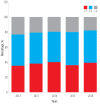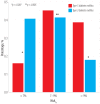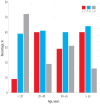Glycemic Control in Patients with Diabetes across Primary and Tertiary Government Health Sectors in the Emirate of Dubai, United Arab Emirates: A Five-Year Pattern
- PMID: 30671180
- PMCID: PMC6330187
- DOI: 10.5001/omj.2019.04
Glycemic Control in Patients with Diabetes across Primary and Tertiary Government Health Sectors in the Emirate of Dubai, United Arab Emirates: A Five-Year Pattern
Abstract
Objectives: In the UAE, the comparative prevalence of diabetes is reported as 18.98%, but there are very few studies evaluating glycemic control. Attaining the optimum glycemic control has been a global challenge over the years. However, there is a trend of global improvement with the availability of newer options of antidiabetic medications, increasing numbers of physicians, and patient awareness. Our primary aim was to assess the level of glycemic control across Dubai Health Authority points of care over the past five years. Additionally, we aimed to compare the differences in glycemic control between primary and tertiary centers, between nationalities, and type I and II diabetes.
Methods: We conducted a retrospective analysis of the electronic medical records of all patients who attended primary and tertiary care centers within the Dubai Health Authority between 2012 and 2016. All patients with any type of diabetes were included in this assessment.
Results: A total of 26 447 patients were included in the study; of these, 73.8% (n = 19 508) were UAE nationals while the other nationalities accounted for 26.2% (n = 6939) of patients. The overall mean glycated hemoglobin (HbA1c) levels from 2012 to 2016 was 7.76%. Patients attending primary care clinics had a mean HbA1c of 7.64% compared to 7.68% for the tertiary care cohort. Out of the total population, 37.7% achieved HbA1c < 7%. Over 40% of the patients attending primary care centers achieved HbA1c < 7% compared to 34.9% of those who attended tertiary care centers.
Conclusions: Optimum glycemic target was achieved by less than 40% of patients. Glycemic control is still below the desired levels. However, there has been a trend of improvement in the last few years and we are achieving the international average targets. Further collaborative actions from clinical, educational, and strategic sectors are needed to improve our goals further.
Keywords: Diabetes Mellitus; Endocrinology; Medicine; Middle East; Public Health; United Arab Emirates.
Figures




Similar articles
-
Lipid Control in Patients with Diabetes across Primary and Tertiary Government Health Sectors in Dubai: A Five-year Pattern.Oman Med J. 2019 Jul;34(4):290-296. doi: 10.5001/omj.2019.58. Oman Med J. 2019. PMID: 31360316 Free PMC article.
-
Glycemic and lipids control in patients with diabetes and cardiovascular or renal diseases across all the government health sectors in the Emirate of Dubai, United Arab Emirates.Diabetes Metab Syndr. 2019 Jan-Feb;13(1):590-594. doi: 10.1016/j.dsx.2018.11.013. Epub 2018 Nov 9. Diabetes Metab Syndr. 2019. PMID: 30641771
-
Mortality and potential years of life lost attributable to non-optimal glycaemic control in men and women with diabetes in the United Arab Emirates: a population-based retrospective cohort study.BMJ Open. 2019 Sep 8;9(9):e032654. doi: 10.1136/bmjopen-2019-032654. BMJ Open. 2019. PMID: 31501134 Free PMC article.
-
A Systematic Review on Pharmaceutical Diabetic Care Services in the United Arab Emirates (UAE).Curr Diabetes Rev. 2021;17(6):e122820189559. doi: 10.2174/1573399817999201228210029. Curr Diabetes Rev. 2021. PMID: 33371838
-
Rapid-Acting Insulin Analogues Versus Regular Human Insulin: A Meta-Analysis of Effects on Glycemic Control in Patients with Diabetes.Diabetes Ther. 2020 Mar;11(3):573-584. doi: 10.1007/s13300-019-00732-w. Epub 2019 Dec 23. Diabetes Ther. 2020. PMID: 31873857 Free PMC article. Review.
Cited by
-
The Impact of Telemonitoring on Improving Glycemic and Metabolic Control in Previously Lost-to-Follow-Up Patients with Type 2 Diabetes Mellitus: A Single-Center Interventional Study in the United Arab Emirates.Int J Clin Pract. 2022 Apr 20;2022:6286574. doi: 10.1155/2022/6286574. eCollection 2022. Int J Clin Pract. 2022. PMID: 35685530 Free PMC article.
-
Association between Dietary Pattern, Weight Loss, and Diabetes among Adults with a History of Bariatric Surgery: Results from the Qatar Biobank Study.Nutrients. 2024 Jul 10;16(14):2194. doi: 10.3390/nu16142194. Nutrients. 2024. PMID: 39064637 Free PMC article.
-
Management of Diabetes and Hypertension within the Gulf Region: Updates on Treatment Practices and Therapies.Diabetes Ther. 2022 Jul;13(7):1253-1280. doi: 10.1007/s13300-022-01282-4. Epub 2022 Jun 9. Diabetes Ther. 2022. PMID: 35679010 Free PMC article. Review.
-
Dietary patterns and glycaemic control among Qatari adults with type 2 diabetes.Public Health Nutr. 2021 Oct;24(14):4506-4513. doi: 10.1017/S1368980020003572. Epub 2020 Oct 9. Public Health Nutr. 2021. PMID: 33032668 Free PMC article.
-
Current gaps in management and timely referral of cardiorenal complications among people with type 2 diabetes mellitus in the Middle East and African countries: Expert recommendations.J Diabetes. 2022 May;14(5):315-333. doi: 10.1111/1753-0407.13266. Epub 2022 Apr 17. J Diabetes. 2022. PMID: 35434900 Free PMC article. Review.
References
-
- International Diabetes Federation Diabetes Atlas 8th ed; 2017.
-
- Klein R, Klein BE, Moss SE, Davis MD, DeMets DL. The Wisconsin Epidemiologic Study of Diabetic Retinopathy. X. Four-year incidence and progression of diabetic retinopathy when age at diagnosis is 30 years or more. Arch Ophthalmol 1989. Feb;107(2):244-249. 10.1001/archopht.1989.01070010250031 - DOI - PubMed
-
- Nathan DM, Genuth S, Lachin J, Cleary P, Crofford O, Davis M, et al. Diabetes Control and Complications Trial Research Group The effect of intensive treatment of diabetes on the development and progression of long-term complications in insulin-dependent diabetes mellitus. N Engl J Med 1993. Sep;329(14):977-986. 10.1056/NEJM199309303291401 - DOI - PubMed
LinkOut - more resources
Full Text Sources
Miscellaneous
